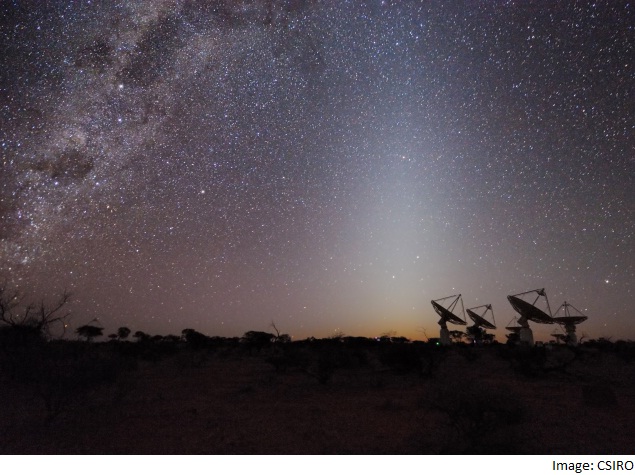- Home
- Science
- Science News
- Galaxy Discovered 5 Billion Light Years Away
Galaxy Discovered 5 Billion Light Years Away

The galaxy was discovered in radio emissions travelling to earth using the Australian Square Kilometre Array Pathfinder telescope (ASKAP).
Six dishes of the telescope, located in a remote desert in Western Australia at the Murchison Radio-astronomy Observatory (MRO), have detected a weak signal emitted prior to the birth of the solar system.
James Allison of Australia's national science agency's Commonwealth Scientific and Industrial Research Organisation (CSIRO) led a research team using ASKAP and MRO's unique radio quietness to crack open a window to a little-explored period of the universe's history.
"At many observatories, this dip would have been hidden by background radio noise, but our site is so radio quiet it stood out clearly," said Allison, an affiliate of ARC Centre of Excellence for All-sky Astrophysics (CAASTRO).
The telescope can pick up signals from galaxies in the distant universe that are sources of radio waves, said Elaine Sadler, professor of astrophysics at the University of Sydney.
The team used a special technique to detect a change in radio waves coming from within the bright centre of the galaxy PKS B1740-517, located near the Ara constellation.
"If that radio signal passes through hydrogen gas, it makes a signature at one particular frequency, like tuning into a radio station. That can tell you the distance the hydrogen has travelled, and that's what this telescope measures," Sadler said.
The five-billion-year-old radio emission was stamped with the 'imprint' of hydrogen gas it had travelled through on its way to earth. The gas absorbs some of the emission, creating a tiny dip in the signal.
Both the scientists are part of a team that will use the absorption technique with ASKAP to find hundreds of galaxies that are up to ten billion light years away and determine how much hydrogen gas they contain.
This will help astronomers understand why star formation, which is fuelled by hydrogen gas, has dropped off in the universe since its peak 10 billion years ago.
For the latest tech news and reviews, follow Gadgets 360 on X, Facebook, WhatsApp, Threads and Google News. For the latest videos on gadgets and tech, subscribe to our YouTube channel. If you want to know everything about top influencers, follow our in-house Who'sThat360 on Instagram and YouTube.
Related Stories
- Galaxy S24 Series
- MWC 2024
- Apple Vision Pro
- Oneplus 12
- iPhone 14
- Apple iPhone 15
- OnePlus Nord CE 3 Lite 5G
- iPhone 13
- Xiaomi 14 Pro
- Oppo Find N3
- Tecno Spark Go (2023)
- Realme V30
- Best Phones Under 25000
- Samsung Galaxy S24 Series
- Cryptocurrency
- iQoo 12
- Samsung Galaxy S24 Ultra
- Giottus
- Samsung Galaxy Z Flip 5
- Apple 'Scary Fast'
- Housefull 5
- GoPro Hero 12 Black Review
- Invincible Season 2
- JioGlass
- HD Ready TV
- Laptop Under 50000
- Smartwatch Under 10000
- Latest Mobile Phones
- Compare Phones
- Huawei Pura 70 Pro+
- Huawei Pura 70 Ultra
- Tecno Camon 30 Premier 5G
- Motorola Edge 50 Fusion
- Oppo A1i
- Oppo A1s
- Motorola Edge 50 Ultra
- Leica Leitz Phone 3
- Asus ZenBook Duo 2024 (UX8406)
- Dell Inspiron 14 Plus
- Realme Pad 2 Wi-Fi
- Redmi Pad Pro
- Cult Shock X
- Fire-Boltt Oracle
- Samsung Samsung Neo QLED 8K Smart TV QN800D
- Samsung Neo QLED 4K Smart TV (QN90D)
- Sony PlayStation 5 Slim Digital Edition
- Sony PlayStation 5 Slim
- IFB 2 Ton 3 Star Inverter Split AC (CI2432C323G1)
- Daikin 1 Ton 3 Star Inverter Split AC (FTKL35UV16W+RKL35UV16W)

















